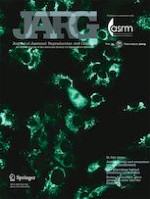Published in:

01-11-2019 | Assisted Reproduction Technologies
Revisiting serum β-hCG cut-off levels and pregnancy outcomes using single embryo transfer
Authors:
Naama Al Mamari, Nabighah Al Zawawi, Suhaib Khayat, Ahmed Badeghiesh, Weon-Young Son, Michael H. Dahan
Published in:
Journal of Assisted Reproduction and Genetics
|
Issue 11/2019
Login to get access
Abstract
Purpose
The objective of this study is to identify the pregnancy outcomes based on day-16 β-hCG level assessed with modern assays, in fresh single embryo transfers.
Methods
A retrospective cohort study at a single academic center between 2013 and 2017. A total of 1076 pregnancies were included.
Results
Pregnancies were divided into 10% groupings of 107–108 patients each. The 10 groups did not differ for baseline characteristics. There was no difference on outcomes based on cleavage or blastocyst transfer. At a serum β-hCG level of 103 ± 13 (range 74–135), 50% had a biochemical loss. Biochemical pregnancy losses remained 21% at serum β-hCG range (136–197). It was only once serum β-hCG level reached 199–252 that the probability of a biochemical pregnancy loss was 12%. Interestingly, if a clinical pregnancy is present even at low day-16 serum β-hCG levels, the likelihood of live birth is approximately 50%. This maximizes to 75% when the serum β-hCG level was at least 253 IU/L. The relationship between serum day-16 β-hCG levels and clinical pregnancy or live birth is quite strong with correlation coefficients above 0.8 which accounted for more than 75% of the variability in outcomes in both cases. Receiver operator curves determined that the cut-off for a clinical pregnancy was 190 and for live birth, it was 213 IU/L.
Conclusion
An increase in the serum β-hCG levels at which to expect a reassuring outcome is required based on modern assays, as compared with the old cut-off levels.